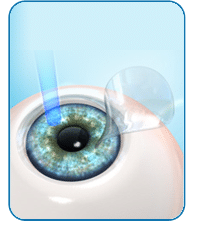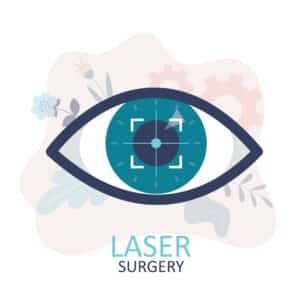PRK Overview
 Photorefractive keratectomy, commonly known as PRK, was the first laser refractive surgery approved by the FDA and has been performed for over 15 years. During PRK, the surgeon reshapes the outer surface of the cornea with an excimer laser, which is an ultraviolet light beam used to precisely remove tissue. By resculpting the corneal tissue, light focuses better into the eye, resulting in clearer vision. Excimer lasers can also be used to correct astigmatism by smoothing the surface of cornea to a more normal shape. PRK differs from LASIK in that no corneal flap is created prior to resculpting the cornea with the excimer laser so the cornea itself is not disturbed. Since PRK does not involve creating a corneal flap, there is quicker recovery with respect to dry eye. Vision improvement is gradual and can take a few days up to 6 months. Surgeons generally recommend PRK for people with thin corneas or moderately dry eyes.
Photorefractive keratectomy, commonly known as PRK, was the first laser refractive surgery approved by the FDA and has been performed for over 15 years. During PRK, the surgeon reshapes the outer surface of the cornea with an excimer laser, which is an ultraviolet light beam used to precisely remove tissue. By resculpting the corneal tissue, light focuses better into the eye, resulting in clearer vision. Excimer lasers can also be used to correct astigmatism by smoothing the surface of cornea to a more normal shape. PRK differs from LASIK in that no corneal flap is created prior to resculpting the cornea with the excimer laser so the cornea itself is not disturbed. Since PRK does not involve creating a corneal flap, there is quicker recovery with respect to dry eye. Vision improvement is gradual and can take a few days up to 6 months. Surgeons generally recommend PRK for people with thin corneas or moderately dry eyes.
PRK Procedure
Dr. Jani will use an excimer laser to reshape the cornea to your precise correction. Prior to applying the laser treatment, the surface cells (epithelium) of the cornea are gently removed; this may be done with a microsurgical eye instrument in conjunction with a dilute chemical solution. The laser treatment typically lasts 30 seconds or less depending upon the amount of correction desired. A soft contact lens is temporarily placed on the cornea to protect the eye and promote comfort and healing of the epithelium. The surgeon will remove this lens during post-operative care after 4-7 days.
The outer layer of the cornea, or epithelium, is a soft, rapidly regrowing layer that regenerates within a few days with no loss of clarity. The deeper layers of the cornea, as opposed to the outer epithelium, have very limited regenerative capacity.
A computer system tracks the patient’s eye position redirecting laser pulses for precise placement. Most modern lasers will automatically center on the patient’s visual axis and will pause if the eye moves out of range and then resume once patient’s eye is re-centered.
PRK Recovery
 Post-operatively, PRK will result in some discomfort. The soft contact lens placed after the procedure along with antibiotic eye drops help healing significantly. Over-the-counter pain relievers and cold compresses may also be helpful to relieve any discomfort. Make up and lotions should be avoided around the eyes until the soft contact lens is removed.
Post-operatively, PRK will result in some discomfort. The soft contact lens placed after the procedure along with antibiotic eye drops help healing significantly. Over-the-counter pain relievers and cold compresses may also be helpful to relieve any discomfort. Make up and lotions should be avoided around the eyes until the soft contact lens is removed.
Post-operatively, PRK will result in some discomfort. The soft contact lens placed after the procedure along with antibiotic eye drops help healing significantly. Over-the-counter pain relievers and cold compresses may also be helpful to relieve any discomfort. Make up and lotions should be avoided around the eyes until the soft contact lens is removed.
PRK versus LASIK
Unlike LASIK, PRK does not carry the risk of a corneal flap dislocation, which may occur (especially with trauma) at any time after LASIK.
For many patients, PRK is a safe, viable alternative to LASIK. Long term studies demonstrate that PRK and LASIK are very equivalent procedures in so far as vision is concerned. The primary difference is the speed of visual recovery. Additionally, PRK recovery is more uncomfortable for the first 2-3 days after the procedure.
Candidates for PRK
By undergoing a comprehensive eye exam, our surgeon, Dr. Jani, will be able to determine if you are an ideal candidate for PRK. Some of the attributes to good candidacy for PRK include:
- Adequate corneal thickness
- A stable eye prescription for at least 12 months
- Good physical and ocular health
- Realistic expectations regarding results of laser vision correction
- Understand the risks and benefits of PRK
- Not a good candidate for LASIK
PRK Risks
As with any surgery, there are some risks involved. Some risks associated with PRK that can be temporary or permanent include:
- Dry eyes
- Persistent glare and / or halos
- Under or over-correction
- Recurrence of myopia, hyperopia, or astigmatism
- Corneal haze
- Scarring
- Pain
- Prolonged epithelial healing period
- Reduced best corrected visual acuity
- Reduced acuity in low light
As with all types of refractive surgery, including LASIK, dry eyes is one of the common risks of PRK surgery and can be permanent. PRK may be performed on one eye at a time to assess the results of the procedure and ensure adequate vision during the healing process if the patient desires. Some activities requiring good binocular vision may have to be suspended between surgeries and during healing periods.
Some PRK patients have complained of glare and halos, but many times these symptoms are resolved after a few months as part of the healing process. Under / over correction of the refractive error is possible, especially with more severe myopia, hyperopia, or astigmatism since the predictability of healing becomes less exact.
Frequently Asked Questions (FAQs) About PRK
How long does PRK recovery take compared to LASIK?
PRK recovery takes longer than LASIK because it removes the cornea’s outer layer. The surface usually takes about four or five days to heal, and vision improves over several weeks. You’ll wear a “bandage” lens to protect your eye for up to a week after PRK surgery. Dr. Jani removes the lens during your follow-up visit. Most people see functional improvement within a week or two, but vision can take up to 3 months to fully stabilize. LASIK patients typically return to regular activities the next day, but PRK patients often need a few extra days off work. While the recovery is slower, the final visual results are similar.
Who is a better candidate for PRK over LASIK?
PRK may be a better choice if you:
- Have thinner corneas
- Have moderately dry eyes
- Are at higher risk of eye trauma (military, contact sports, etc.)
- Have corneal irregularities
- Are not eligible for LASIK for these or other reasons
PRK removes less tissue, so it’s often a good option for people who wouldn’t qualify for LASIK. Dr. Jani evaluates your eye health and lifestyle before making a recommendation.
Is PRK as good as LASIK for vision correction?
Yes, PRK and LASIK offer similar improvements in vision, both offering dramatic improvements.
Is PRK permanent, or will I need future procedures?
PRK permanently reshapes the cornea to correct refractive errors. However, it’s normal to experience reduced near vision focus (presbyopia) as you age, so you may need reading glasses starting sometime around age 40. If you develop cataracts, a common problem in many people in their 60s and older, you may need cataract surgery to replace a clouded eye lens with a clear intraocular lens (IOL) later in life. However, after cataract surgery, you won’t need further vision correction procedures.
Can both eyes be treated at the same time with PRK?
Yes, both eyes can be treated on the same day. However, because the recovery period is more uncomfortable than LASIK, some people choose to have one eye done at a time. Talk to Dr. Jani about your schedule, daily responsibilities, and comfort level before deciding on a treatment plan.
What restrictions should I expect during PRK recovery?
During the first few days, your eyes may feel sore, gritty, or light-sensitive. You’ll wear a bandage contact lens to protect the healing surface. Most patients are advised to avoid:
- Driving for several days
- Eye makeup for at least a week
- Heavy exercise or swimming for a week or more
- Rubbing or touching the eyes
You’ll also use prescription antibiotic drops to prevent infection and reduce inflammation. Most people return to work within a week.
How does PRK improve astigmatism or nearsightedness?
With PRK, Dr. Jani uses an excimer laser to reshape the curvature of your cornea:
- For nearsightedness (myopia), the laser flattens the cornea
- For astigmatism, it smooths out irregular parts of the cornea for more even focus
- For farsightedness (hyperopia), it steepens the cornea’s center
This correction allows light to focus more precisely on your retina, which improves vision.
PRK in Fredericksburg and Culpeper, VA
If you’re curious whether PRK is right for your eyes, call us in Fredericksburg or Culpeper at 540-208-5827 to schedule an appointment.
Call us to explore your options towards visual freedom. Consider laser vision correction and schedule a free consultation with Dr. Jani, a fellowship trained laser vision correction and cornea specialist. After all your eyes are too important to trust to just anyone! Please contact Vista Eye for more information about laser vision correction, or to schedule an appointment today.


